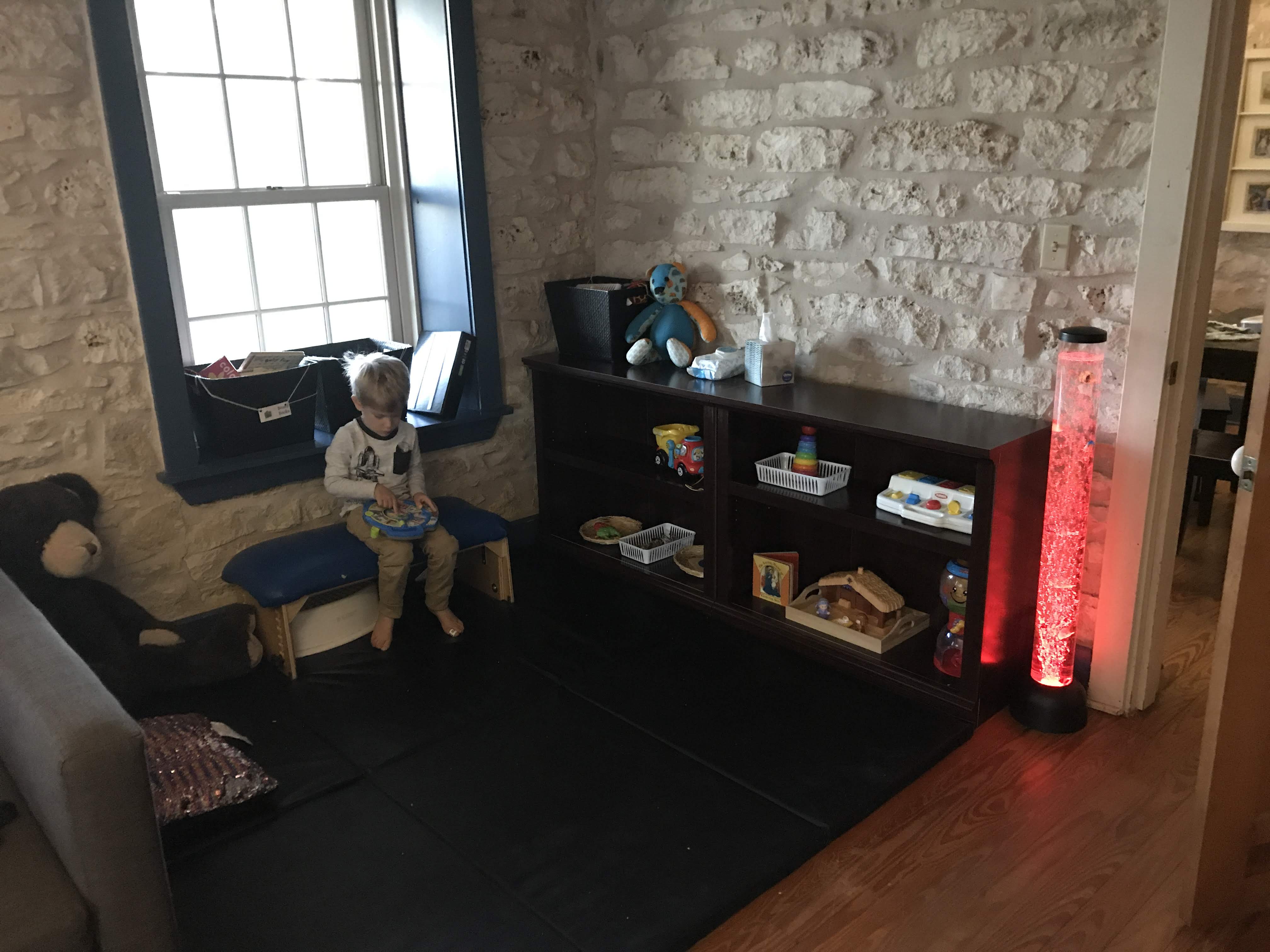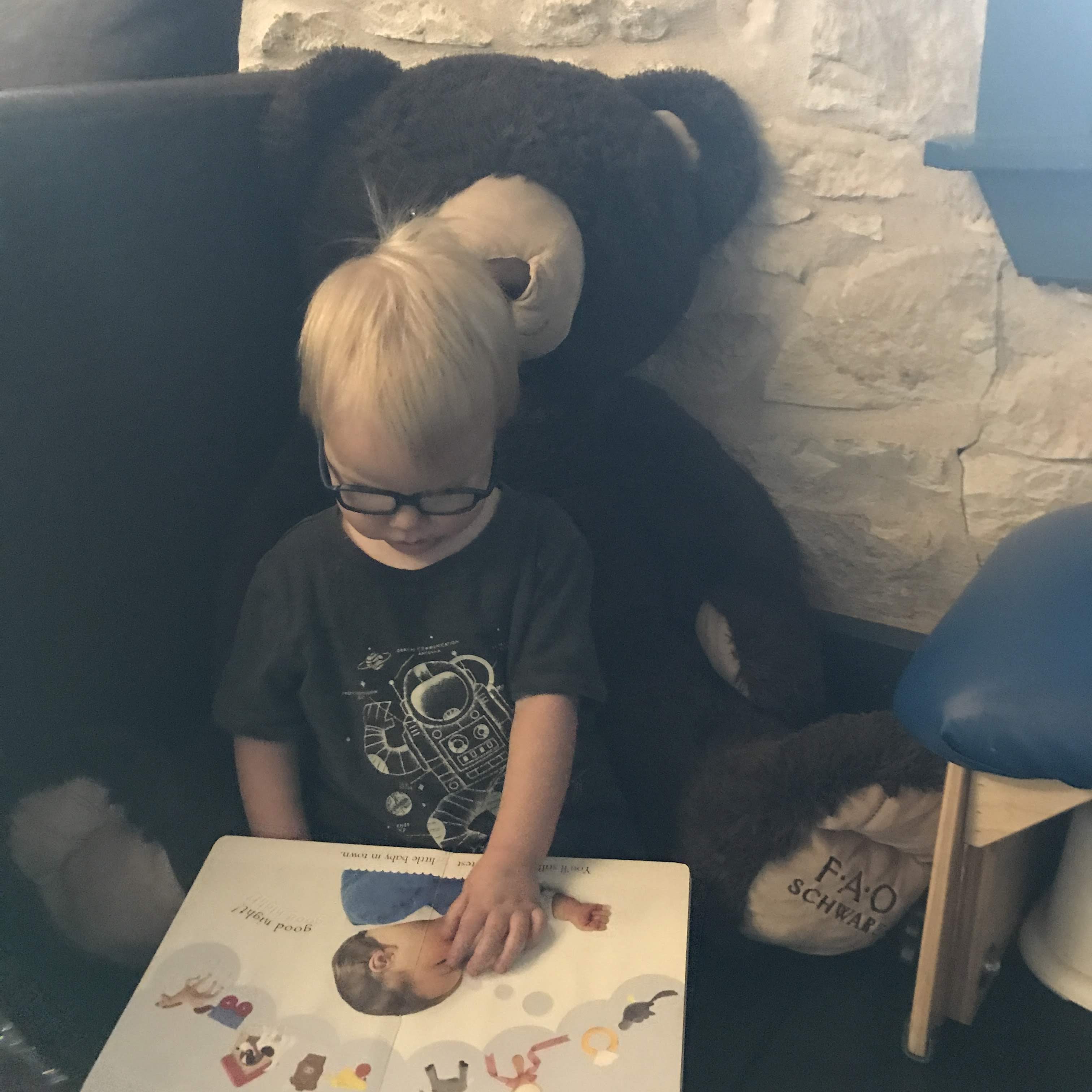
How we (fake) toddler Montessori at home with a special needs child
Oscar hit the big 0-3 last week. I still regularly call him, “Baby Oscar,” and one of my kids regularly contradicts, “He’s not a baby!”
 Not a baby, indeed. So much not a baby that we finally turned him around to face forward while we ride (and to save our backs from having to heft all thirty floppy pounds of him up three stairs into the van, across an entire bench row, and over the side of his car seat).
Not a baby, indeed. So much not a baby that we finally turned him around to face forward while we ride (and to save our backs from having to heft all thirty floppy pounds of him up three stairs into the van, across an entire bench row, and over the side of his car seat).
His play space was also still pretty babyish, affectionately known as “Baby Jail.” It was enclosed by a 6×6 foot gated fence to keep the puppy (and dirty shoes) out, a cluttered jumble of whatever toys happened to get tossed in there. Although it was near the center of action, and we were always assured Oscar was safe when he played there, he was actually too safe and contained. We noticed an unwillingness to explore, or move, or generally get into the kind of age-appropriate trouble you should expect from a three year old kid.
So, for his third birthday, this happened:

A new Montessori-style play area, with no gate, open to the wide, wide world. (It is now a very inviting nook for siblings, too, as you can see.) Developmentally, Oscar is at about 9-12 months, the age at which all our other kids started learning to manage their own desires, in small calibrated doses. We’ve been encouraging Oscar for two years, in speech and other therapies, to express himself and to make choices, but his opportunities for doing that at home have been more limited — we just carted him from place to place like a baby.
The Montessori method calls for a “prepared environment” with beautiful, natural materials whenever possible, fostering independence and concentration. All of our other children have had preschool Montessori instruction through our homeschool group, but that classroom setup won’t work for 3-year-old Oscar. We replaced his enormous bin of jumbled electronic toys with open shelving, curated and rotated on a regular basis. We stowed away almost everything that whiz-bangs or lights up, toys that fostered not concentration but repetitive whacking for quick rewards.
So Oscar can now work instead (with lots of help from the whole family) on:
- Choosing and putting away
- Concentration
- Self-directed movement
- Goal setting and motor planning
- Hand-eye coordination
- Receptive communication
Toddler Montessori is not a perfect match, because Oscar’s not really a typical 9-12 month old, chronologically or developmentally. His pace is not just slow, it is also more uneven than usual — his cognitive, social, fine motor, gross motor, and communication development aren’t all aligned in the same ranges; even within those realms there are some things he can do (right now) and some things he can’t (maybe ever).
But what we love about Montessori, and what does work, is that it empowers him to take ownership, to easily express his preferences on a regular basis and in a way that we can understand, and to engage — or not — with his environment and his family. He could crawl right off the mat and out the door if he wanted to… and we want him to want to. His old playpen-style setup actually hindered that.
His favorite sensory bubble tube, the object most likely to convince him to move, is near the exit. Whenever it’s turned on, he crawls over immediately to pat it, talk to it, and gaze lovingly into its depths. On the other side of the shelves, we have his therapy bench and a small stool set up, so he can use them as a “table.”
Here’s what Oscar’s “12 month” DIY Montessori shelves look like right now.

Shelf One:
- See-N-Say with farm animal sounds
- Dump truck to practice in-and-out
- Assortment of chew toys
- Schleich safari animals
- Single-shape puzzle

Shelf Two:
- Stacking ring tower
- Animal pop-up toy
- Board book, The Saving Name of the Son of God
- A simplified Little People nativity set
- Fisher-Price Gumball Machine
Eventually, as his development progresses and his concentration improves, I’ll incorporate more actual Montessori work, such as hand transfer from one bucket to another. Many of the toys pictured are aimed at the same goals as “purist” Montessori objects: the gumball machine and pop-up animals both work on object permanence, like an Imbucare box. A few things here still make noise, but only if you’re pretty deliberate about it. Oscar does need a higher payoff-to-input ratio than a typical child.
The other corner is a small reading nook, where we leave one book at a time for him to explore. (This week: Hush Little Baby… um, Big Boy.) The teddy bear is big enough to cuddle two together, and the reversible sequin pillow nearby is a huge draw even with the over-three crowd.

Some open questions: Will it all still become a jumbled mess? How long will it take before Oscar would rather crawl toward the nearby school supplies than his own toy shelf?
What will the dog eat first?
Stay tuned!
